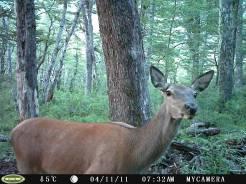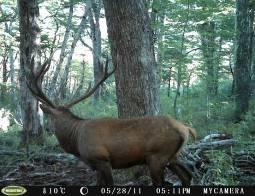Nicolas Ferreyra
Other projects
10 Nov 2010
Impact of the Red Deer (Cervus elaphus) on High Priority Conservation Native Forest in Patagonia, Argentina I
Red deer (Cervus elaphus) was introduced in several countries of the world. In Argentina they have invaded some National Parks and the type, magnitude and extent of its impact on native ecosystems are poorly known. We will continue evaluating the population status (relative abundance and population structure) and its relationship with the impact to the understory vegetation on high priority native forests at Lanín National Park.

The Red Deer Management Plan began in 2008. Since then, we build up the deer and vegetation monitoring protocol. The activities took place within three watersheds (Lolog, Tromen and Quillén) on Lanín National Park (LNP) covering more than 500 km2. Each of these watersheds represents a different red deer situation according to invasion history and animal population abundance.

With the first RSG (8856-1) we partially implemented the vegetation protocol to evaluate the deer impact, measuring 71 transects within 14 plots (Lolog & Tromen). Although we measure some plots without deer presence, we still have to set up some plots in Quillén (control site without deer) and strengthen the Lolog information. Also with the first grant we advanced on the red deer population survey by direct observations of animals and by setting up 8 camera trap in order to complement and increase the abundance and population structure information at Tromen. In average, each camera was active 127 days. With these cameras we survey five different vegetation types (Lenga, Ñire, Ciprés, Raulí and Araucaria forests).

With this new Grant we will be able to guarantee a long-lasting contribution to conservation by finishing the vegetation surveys at all the forest types and watersheds and finishing the evaluation of the red deer population status at Tromen and Lolog. By this work we could be the first case in southern Chile and Argentina in carrying out the evaluation of deer impact in relation to animal population abundance and structure. Knowing the vegetation impact level produced by different red deer population conditions is fundamental for management. This valuable data will be useful as baseline information for red deer management within and outside National Parks in Patagonia at a regional scale.
On the other hand, this proposal will provide new scientific information to the National Park Administration that will be useful to discuss the red deer management within 50.000 km2 with others private and public stakeholders at different parks and provinces within Patagonia in the context of Climate Change, that predicts for the future better condition for deer winter survivorship and therefore an increase of abundance and distribution of this invasive mammal.